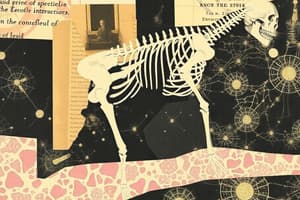Podcast
Questions and Answers
What components make up the skeletal system?
What components make up the skeletal system?
Bone, cartilage, tendons, ligaments.
Which of the following is NOT a component of the bone's extracellular matrix?
Which of the following is NOT a component of the bone's extracellular matrix?
- Red blood cells (correct)
- Proteoglycans
- Collagen
- Ground substance
Collagen provides flexible strength to bones.
Collagen provides flexible strength to bones.
True (A)
What is the primary function of osteoblasts?
What is the primary function of osteoblasts?
Which type of bone is characterized by its porous structure?
Which type of bone is characterized by its porous structure?
What process describes the formation of bone by osteoblasts?
What process describes the formation of bone by osteoblasts?
Bone is the major storage site for ______.
Bone is the major storage site for ______.
Osteoclasts are responsible for bone formation.
Osteoclasts are responsible for bone formation.
Match the following bone cells with their functions:
Match the following bone cells with their functions:
What happens when blood calcium levels are too high?
What happens when blood calcium levels are too high?
What type of ossification occurs within connective tissue membranes?
What type of ossification occurs within connective tissue membranes?
What is the primary function of the periosteum?
What is the primary function of the periosteum?
Flashcards are hidden until you start studying
Study Notes
Overview of the Skeletal System
- Composed of connective tissues including bone, cartilage, tendons, and ligaments.
- Functions include support, protection, movement, mineral storage, and blood cell production.
Bone Histology
- Extracellular Matrix: Composed of collagen, ground substance, organic molecules, water, and minerals.
- Collagen: Provides flexible strength; represents 90% of the organic content in bone.
- Proteoglycans: Polysaccharides that attract water, contributing to the matrix's hydration and resilience.
Bone Structure
- Bone Matrix: Arranged in lamellae, with cavities (lacunae) occupied by osteocytes and canaliculi connecting these cells.
- Endosteum: Lines medullary, marrow, and vascular cavities.
- Periosteum: Contains blood vessels and nerves, essential for bone health and repair.
- Types of Bone:
- Spongy Bone: More porous, consists of trabeculae providing strength without extra weight.
- Compact Bone: Dense, structured for maximum strength.
Bone Cells
- Osteoprogenitor Cells: Stem cells that differentiate into osteoblasts or chondroblasts.
- Osteoblasts: Responsible for bone formation and repair; become osteocytes after matrix maturation.
- Osteocytes: Maintain the surrounding matrix; principal cells in mature bone.
- Osteoclasts: Multinucleated cells that resorb bone; crucial for bone remodeling.
Bone Development
- Ossification: The process of bone formation primarily through osteoblast activity.
- Intramembranous Ossification: Bone develops within connective tissue membranes, forming flat bones.
- Endochondral Ossification: Bone replaces hyaline cartilage; typical in long bones.
Bone Growth
- Appositional Growth: Increases bone width as osteoblasts deposit new matrix on the surface.
- Growth in Length: Occurs at the epiphyseal plate through endochondral ossification.
Bone Remodeling
- Involves the dynamic process of bone resorption by osteoclasts followed by deposition by osteoblasts.
- Facilitates adaptation to stress, changes in bone shape, repairs, and calcium regulation.
Calcium Homeostasis
- Bones serve as the primary storage site for calcium.
- High Blood Calcium: Decreased osteoclast activity; osteoblasts absorb calcium to form new bone.
- Low Blood Calcium: Increased osteoclast activity releases calcium into the bloodstream.
Hormonal Regulation
- Parathyroid Hormone: Released in response to low blood calcium levels, regulates osteoclast activity to increase calcium concentration in the blood.
Studying That Suits You
Use AI to generate personalized quizzes and flashcards to suit your learning preferences.




